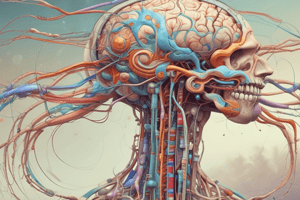Podcast
Questions and Answers
Match the following brain structures with their primary functions:
Match the following brain structures with their primary functions:
Pons = Connecting spinal cord with brain and regulating sleep Hypothalamus = Regulating body temperature and autonomic activities Cerebellum = Coordinating voluntary muscles Thalamus = Main relay station for sensory impulses
Match the following parts of the brain with their characteristics:
Match the following parts of the brain with their characteristics:
Midbrain = Contains centers for visual and auditory reflexes Reticular Formation = Filters sensory input and maintains consciousness Epithalamus = Includes the pineal gland affecting cyclic activities Cerebrum = Responsible for conscious thought and voluntary motor functions
Match the following functions with the respective areas they monitor:
Match the following functions with the respective areas they monitor:
Cerebral Cortex = Conscious awareness of sensations Limbic System = Emotional regulation Substantia Nigra = Suppresses unwanted muscle contractions RAS = Helps control muscle tone and posture during movements
Match the following aspects of the cerebrum with their descriptions:
Match the following aspects of the cerebrum with their descriptions:
Match the following components with their corresponding brain functions:
Match the following components with their corresponding brain functions:
Match the following brain structures with their primary functions:
Match the following brain structures with their primary functions:
Match the following terms related to the central nervous system with their definitions:
Match the following terms related to the central nervous system with their definitions:
Match the following concepts about brain metabolism with their effects:
Match the following concepts about brain metabolism with their effects:
Match the following systems of the nervous system with their descriptions:
Match the following systems of the nervous system with their descriptions:
Match the following areas of the brain with the appropriate related functions:
Match the following areas of the brain with the appropriate related functions:
Flashcards are hidden until you start studying
Study Notes
Course Overview
- Instructor: Dr. Rayan Khalid, MBBS, M.Sc, MD
- Topics Covered: Applied Anatomy, Sensory System, Pain, Reflex & Motor Systems, Higher Functions, Limbic System, Sleep & EEG, Special Senses.
Nervous System Divisions
- Central Nervous System (CNS): Includes brain and spinal cord; responsible for processing and transmitting information.
- General Terminology:
- Gyri: Raised areas of the brain.
- Sulci: Fissures between gyri.
- Gray Matter: Contains cell bodies, dendrites; found in the cortex and inner spinal cord.
- White Matter: Composed of myelinated axons; facilitates communication within the CNS.
Brain Anatomy
- Weight: Approx. 1,600 g in men, 1,450 g in women.
- Functionality: Consumes 20% of oxygen at rest, highest metabolic activity; requires continuous glucose supply.
- Vulnerability: 1-2 min without blood flow can impair function; over 4 min can cause permanent damage.
Major Brain Structures
- Brain Stem: Comprised of medulla, pons, and midbrain; regulates basic life functions.
- Medulla: Controls vital functions like cardiac and respiratory centers.
- Pons: Connects different brain parts; involved in sleep and bladder control.
- Midbrain: Contains centers for auditory and visual reflexes, including the substantia nigra, which moderates unwanted muscle movements.
Diencephalon Functions
- Thalamus: Primary relay station for sensory impulses to the cortex.
- Hypothalamus: Regulates autonomic functions including temperature, hunger, and thirst.
- Limbic System: Responsible for emotion and memory.
Cerebellum
- Location: Positioned below the cerebrum.
- Function: Coordinates voluntary muscle movements and maintains balance.
- Pathology: Disease can result in ataxia (loss of coordination).
Cerebrum Structure
- Hemispheres: Two hemispheres joined by the corpus callosum.
- Cortex: Outer layer of gray matter involved in higher-order functions.
- Left Hemisphere: Focused on language and analytical skills; controls right body side.
- Right Hemisphere: Handles nonverbal tasks and spatial awareness; controls left body side.
- Hemispheric Dominance: 90% of individuals are left-dominant, affecting handedness and cognitive functions.
Cerebral Lobes
- Frontal Lobe: Involved in thought elaboration, motor function, and personality.
- Parietal Lobe: Contains sensory cortex for touch and proprioception.
- Temporal Lobe: Processes auditory information and balance.
- Occipital Lobe: Dedicated to visual processing.
Spinal Cord
- Dimensions: Approximately 17-18 inches long, extending from the foramen magnum to lower lumbar vertebrae.
- Regions: Divided into cervical, thoracic, lumbar, and sacral regions.
- Cauda Equina: Bundle of nerve roots at the terminal end of the spinal cord.
Ascending Spinal Tracts
- Three Neuron Pathway:
- First Order Neurons: From receptors to spinal cord.
- Second Order Neurons: From spinal cord to subcortical areas.
- Third Order Neurons: From subcortex to cerebral cortex.
CNS Protection
- Protective Structures: Includes bone (skull and vertebrae), adipose tissue, meninges, and cerebrospinal fluid (CSF).
- Meninges: Composed of dura mater, arachnoid layer, and pia mater; protects and supports the brain and spinal cord.
Meningeal Extensions
- Falx Cerebri: Separates cerebral hemispheres.
- Falx Cerebelli: Divides cerebellar hemispheres.
- Tentorium Cerebelli: Separates cerebrum from cerebellum.
Cerebrospinal Fluid (CSF)
- Volume: Approximately 140 ml; cushions the brain.
- Ventricles: Interconnected cavities producing CSF, including lateral, third, and fourth ventricles.
Peripheral Nervous System (PNS)
- Composition: Includes 43 pairs of nerves; sensory and motor neurons.
- Cranial Nerves: 12 pairs responsible for sensory and motor functions; categorized as sensory, motor, or mixed.
- Spinal Nerves: 31 pairs, all mixed; named by the vertebral level from which they arise.
Cranial Nerve Functions
- Sensory Nerves: Olfactory, Optic, Vestibulocochlear.
- Mixed Nerves: Trigeminal, Glossopharyngeal.
- Motor Nerves: Oculomotor, Trochlear, Abducens, Hypoglossal, Facial, Vagus, Accessory.
Spinal Nerve Structure
- Roots: Comprised of dorsal (sensory) and ventral (motor) roots; converge to form mixed spinal nerves.
Studying That Suits You
Use AI to generate personalized quizzes and flashcards to suit your learning preferences.




